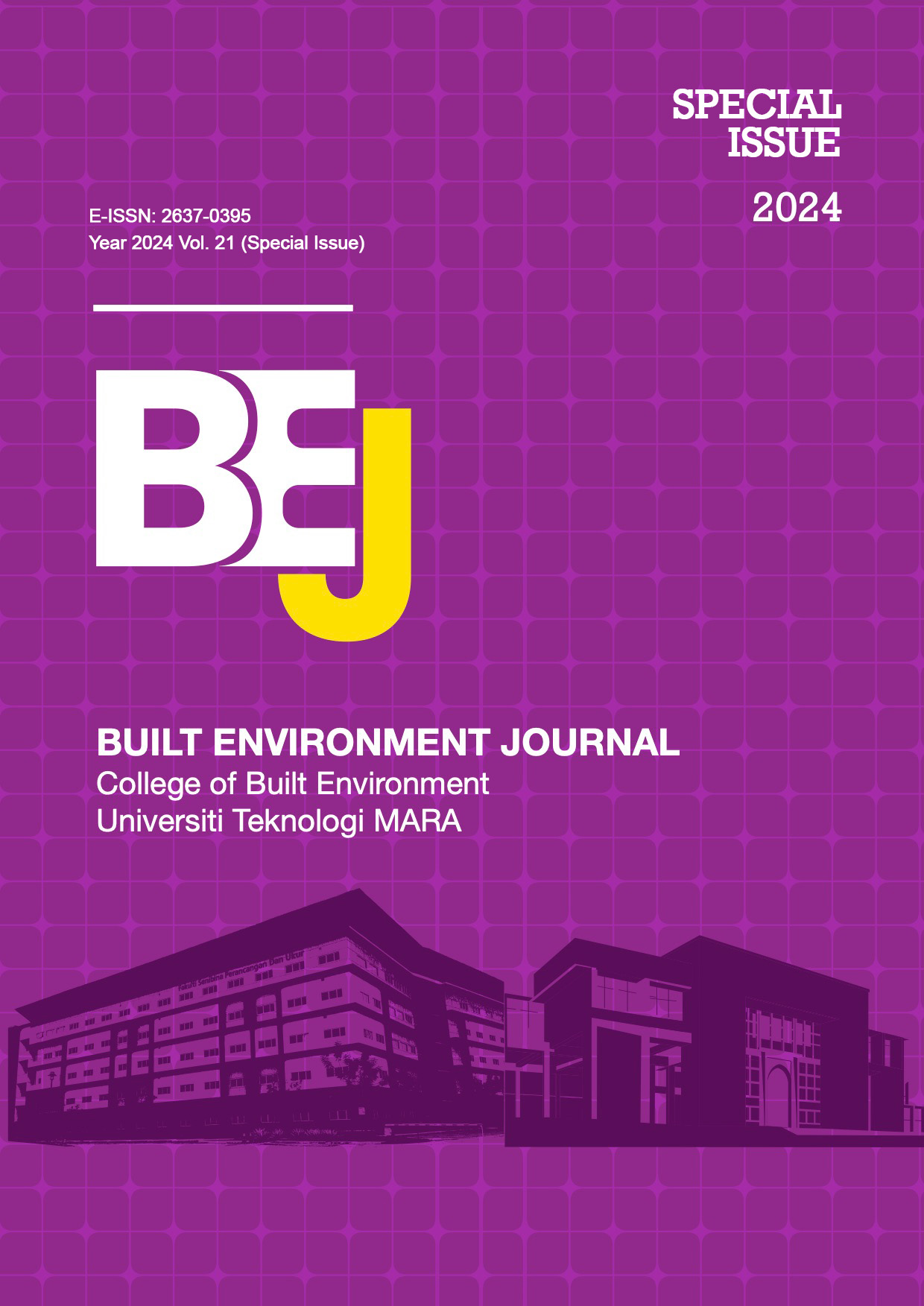Assessing Aristocratic Architectural Styles Through the Malay Classical Evaluation Tool
DOI:
https://doi.org/10.24191/bej.v21iSI.1881Keywords:
Classical Architecture, Architectural Styles, Malay Aristocracy, Aristocratic ArchitectureAbstract
Particularly throughout the modernising 'colonial' period of the early 1800s to 1900s in the Malay world, colonial forces and influences catalysed changes to public architecture in the Malay world. Along with construction materials and technology imported from outside, there were also stylistic forms and language. In some cases, the Malay patrons of architecture adopted external stylistic elements while appropriating masonry into new 'hybrid' forms of their vernacular. A range of stylistic conditions and features arose from this evolution, and construction and localised grammar had evolved. Thus, the following is an attempt to classify according to the parameters of stylistic characters. The most-argued issues are about traditional Malay and classical Malay inventions and appropriations rather than colonial or European ones. The cases show the stylistic grammar of masonry and timber with characteristic proportions, tectonics, and artistic motifs reflecting local Malay traditions, forms, and constructional inventions. The style's evolution reflects the gradual evolutionary outcome of classical Malay architecture. The reviews from the scholars about the Malay traditional façade elements and stylistic characters had been mapped out and summarised into a matrix and scorecard for further studies. Proper documentation of the architectural principles of South-east Asia will help preserve Malay principal character, which must go beyond vernacular models into the strong façade identity and principles that fashion a new era of urban language.
References
Abidin, N. Z., Shahminan, R. N. R., & Ibrahim, F. K. (2017). Architectural influences of Istana Lama Seri Menanti, Negeri Sembilan. Planning Malaysia, 15(1), 151–162. https://doi.org/10.21837/pmjournal.v15.i6.230
Andaya, L. Y. (2004). The Search for the "Origins" of Melayu. In T. P. Barnard (Ed.), Contesting
Asia, S. (2004). Southeast Asian urbanism: from early city to Classical state. 74–93. https://doi.org/10.1017/CHO9781139035606.006
Bosman, G., & Whitfield, C. (2015). Perceptions of vernacular architecture. Vernacular Architecture: Towards a Sustainable Future, 978–1. https://doi.org/10.1201/b17393-30
Evolution, T. H. E., & Malay, O. F. (2019). Fabrications The Journal of the Society of Architectural Historians , Australia and New Zealand Petrification as a transformative Vernacular form Based on Semper' s' Four Elements .'
Jahn Kassim, P. S., Abdul Majid, N. H., Md Sharif, H., & Abdul Kadir, T. A. Q. R. (2018). Hybrid Aesthetics Classification in Malay Neo-Classicality Reinventing Identity Through Aristocratic Structures. Asia Proceedings of Social Sciences, 1(4), 71–75. https://doi.org/10.31580/apss.v1i4.494
Jahnkassim, Puteri Shireen, Abdul Majid, Noor Hanita, Nawawi, N. (2017). The Resilience of Tradition. Areca Books.
Kassim, Shireen Jahn Abdullah, Alias Salleh, E. (2018). Urban design vocabulary from typological and morphological patterns and forms of traditional Malay urban cores. October, 1–12.
Müller, M. (2014). Indonesia and the Malay World Manufacturing Malayness. Indonesia and the Malay World, 42(123), 170–196. https://doi.org/10.1080/13639811.2014.912409
Nawawi, N. M., Hanita, N., Majid, A., & Jahnkassim, S. (2018). Classifying the Early Modern Stylistic Tendencies of Classical Malay Palaces in INHERIT77 Classifying the Early Modern Stylistic Tendencies of Classical Malay Palaces in a Taxonomy of Hybrid Architectural Language.
Pieterse, J. N. (2018). Globalisation as hybridisation. In Sociology of Globalisation: Cultures, Economies, and Politics. https://doi.org/10.4324/9780429493089.
Powell, R., Kusumo, C. M. L., & Srirangam, S. (2019, February). Rethinking the public realm: behaviour settings in Malaysian cities. In IOP Conference Series: Materials Science and Engineering (Vol. 471, No. 9, p. 092087). IOP Publishing. https://doi.org/10.1088/1757-899X/471/9/092087
Ramele, R., Yaman, Y. N. A., & Muhammad Ariff, N. R. (2021). Modernization of traditional Malay house in heritage village of Malacca. Built Environment Journal (BEJ), 18(1), 23-30. https://doi.org/10.24191/bej.v18i1.11415
Salam, H., Nik Lukman, & Mohd Farid. (2023). Malay Architecture Symbolism: From the Worldview of Islamic Intellectual Tradition. Penerbit Universiti Kebangsaan Malaysia. p. 37.
Shaffee, N., & Said, I. (2008). Evolution of Carving Motifs in Malay Vernacular. Seminar Warisan Seni Ukir Kayu Melayu: Warisan Nik Rashiddin Nik Hussein, 131–141.
Shireen, P., Kassim, J., Hanita, N., & Majid, A. (2017). A definition of Malay Classicality amidst Colonial change : Deriving language , principles and forms. 1.
Templer, J. (1990). Architectural research. Journal of Architectural Education, 44(1), 3-3. https://doi.org/10.1080/10464883.1990.11102661
Tzonis, A., & Lefaivre, L. (1986). Classical architecture: The poetics of order. Mit Press. In De Taa/llan de K/assicistiese Architektuur. https://doi.org/10.1093/oxfordhb/9780199571451.013.0013
Downloads
Published
Versions
- 01-05-2025 (2)
- 31-12-2024 (1)
How to Cite
Issue
Section
License
Copyright (c) 2024 Tengku Anis Qarihah Raja Abdul Kadir, Puteri Shireen Jahn Kassim, Abdul Razak Sapian

This work is licensed under a Creative Commons Attribution-NonCommercial-NoDerivatives 4.0 International License.
CC BY-NC-ND 4.0 DEED
Attribution-NonCommercial-NoDerivs 4.0 International












